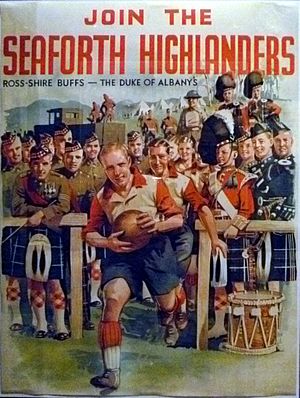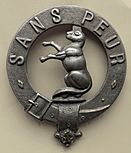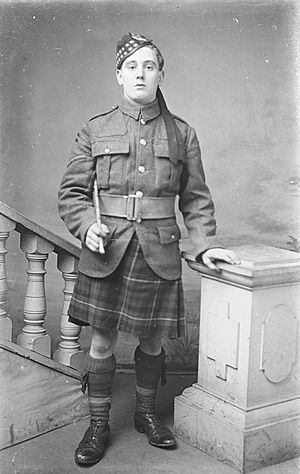Seaforth Highlanders facts for kids
Quick facts for kids Seaforth Highlanders |
|
|---|---|
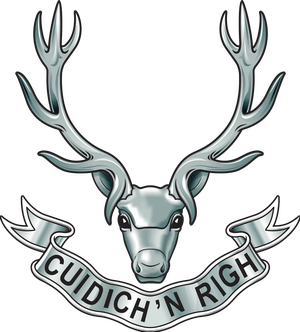
Cap badge of the Seaforth Highlanders.
|
|
| Active | 1881–1961 |
| Country | |
| Branch | |
| Type | Line Infantry |
| Part of | Highland Brigade |
| Garrison/HQ | Fort George, Inverness |
| Motto(s) | Cuidich 'n Righ (Aid the King) |
| Battle honours | See below |
| Commanders | |
| Colonel of the Regiment |
Edward, Prince of Wales (1920–36) |
| Insignia | |
| Tartan (Mackenzie) |
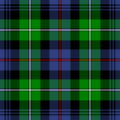 |
The Seaforth Highlanders was a famous Scottish army regiment. It was part of the British Army. This regiment was mostly linked to the northern parts of the Scottish Highlands. The Seaforth Highlanders existed from 1881 to 1961. They fought in many conflicts, including World War I and World War II. In 1961, the regiment joined with the Queen's Own Cameron Highlanders. They formed a new group called the Queen's Own Highlanders (Seaforth and Camerons). Later, in 1994, this group merged again. They joined with the Gordon Highlanders to create the Highlanders (Seaforth, Gordons and Camerons). Today, they are part of the larger Royal Regiment of Scotland.
Contents
History of the Seaforth Highlanders
How the Regiment Started
The Seaforth Highlanders regiment began in 1881. It was formed by combining two older regiments. These were the 72nd (Duke of Albany's Own Highlanders) Regiment of Foot and the 78th (Highlanders) (Ross-shire Buffs) Regiment of Foot. They became the 1st and 2nd battalions of the new regiment. This change was part of army updates called the Childers Reforms.
The regiment was named after Kenneth Mackenzie, 1st Earl of Seaforth. His cousin, Francis Mackenzie, 1st Baron Seaforth, also helped. They had originally created the 72nd and 78th regiments. At first, the new regiment was called "Seaforth Highlanders (Ross-shire Buffs)". On November 22, 1881, Queen Victoria approved its full name. It became "Seaforth Highlanders (Ross-shire Buffs, The Duke of Albany's)".
The 1st battalion saw action in September 1882. This was at the Battle of Tel el-Kebir during the Anglo-Egyptian War. They returned home but went abroad again in 1896. They helped in the occupation of Crete in 1897. They also helped in the reconquest of Sudan. They were at the Battle of Atbara in April and the Battle of Omdurman in September 1898. After this, they moved to Cairo. From late 1902, they were stationed in India.
In 1881, the 2nd battalion was in India. They served on the North West Frontier. They took part in the Hazara Expeditions in 1888 and 1891. They also joined the Chitral Expedition in 1895. They came home in 1897. When the Second Boer War started, the 2nd Battalion went to South Africa in November 1899. They had many losses at the Battle of Magersfontein in December 1899. They also fought at the Battle of Paardeberg in February 1900.
The 3rd battalion was a Militia group. It was called up in late 1899. In February 1900, it went to Egypt to serve with the 1st battalion. In 1908, the army changed how it was organized. The regiment then had one Reserve and three Territorial battalions.
The First World War (1914-1918)
Regular Army Battalions
The 1st Battalion had been serving in India. It arrived in France in October 1914. This was for service on the Western Front. They fought at the Battle of Aubers Ridge in May 1915. The battalion then moved to Mesopotamia in December 1915. They took part in the Siege of Kut and the Fall of Baghdad in March 1917. Later, they moved to Palestine in January 1918.
The 2nd Battalion was stationed in England. It arrived in France in August 1914. They took part in the retreat from Le Cateau. They also fought in the Battle of the Marne and the Battle of the Aisne. In October 1914, they were at the Battle of Messines. They also fought in the Second Battle of Ypres in April 1915. Later, they were in the Battle of the Somme in 1916 and the Battle of Arras in 1917. The battalion also saw action at the Battle of Passchendaele in 1917. They fought in the Battle of the Lys in April 1918. They were also part of battles on the Hindenburg Line and the final advance in Picardy.
Territorial Force Battalions
The 1/4th (Ross Highland) Battalion arrived in France in November 1914. The 1/5th (Sutherland and Caithness) Battalion and the 1/6th (Morayshire) Battalion arrived in France in May 1915. All three battalions continued to serve on the Western Front until the war ended.
New Army Battalions
The 7th (Service) Battalion arrived in France in May 1915. The 8th (Service) Battalion arrived in France in July 1915. The 9th (Service) Battalion also arrived in France in May 1915. All three battalions continued to serve on the Western Front until the war ended. The 1st Garrison Battalion arrived in Salonika in August 1916. This was for service on the Salonika front.
Between the World Wars
The 1st Battalion returned from Egypt in 1919. In 1921, they helped keep order during a miners' strike. They moved to Palestine in 1933 and to Hong Kong in 1937. In March 1938, the 1st Battalion went to Shanghai. Meanwhile, the 2nd Battalion went to India in 1918. They saw action on the North-West Frontier in 1930–31. Then they moved to Palestine in 1932 and returned to Britain in 1934.
In 1921, the Seaforth's part of the Territorial Army changed. It now included a combined 4/5 battalion and the 6th battalion. In 1939, the Territorial Army grew. This led to the Seaforth having four Territorial units: the 4th, 5th, 6th, and 7th battalions.
The Second World War (1939-1945)
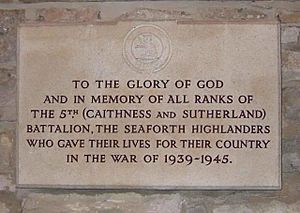
The 1st Battalion was in Shanghai when the war started. It moved to Malaya in November 1940, and then to India. They joined the 1st Indian Brigade in May 1942. They served in the Burma Campaign until 1945.
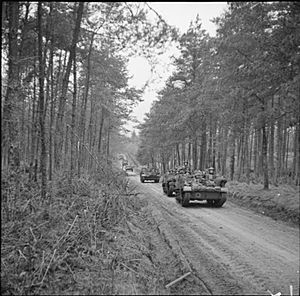
The 2nd Battalion went to France in October 1939. But they were captured in June 1940 during the Battle of France. The 2nd Battalion was then reformed. They served in the Middle East. They fought in the Second Battle of El Alamein and the Tunisia Campaign. They also took part in the Allied invasion of Sicily. In late 1943, they returned to the United Kingdom. They then joined Operation Overlord, the Allied invasion of Normandy. They helped capture the French port of Le Havre. The battalion later fought in Operation Veritable and Operation Plunder. They also took part in the invasion of Germany.
The 4th Battalion also went to France in January 1940. They were captured in June 1940, just like the 2nd Battalion.
After serving at home, the 5th Battalion joined the reformed 51st Highland Division in 1940. They served in the Middle East. They were part of the Allied invasion of Sicily in July 1943. They also joined the Allied invasion of Italy in September 1943. Then they fought in North-West Europe.
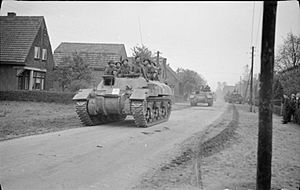
The 6th Battalion was a second-line Territorial Army unit. It served with the 5th Infantry Division throughout the war. They fought in Sicily, Italy, and finally in Northwest Europe.
The 7th Battalion was also a second-line Territorial Army unit. It later joined the 15th (Scottish) Infantry Division. They went to France in June 1944. They saw action in Operation Epsom and then served in North-West Europe.
The 8th and 9th battalions were formed early in the war. They mainly served in home defence and reserve roles. In December 1941, the 8th was renamed the 30th battalion.
After the War and Merging Regiments
After the war, the 1st battalion served in Java. Then they moved to Malaya. From 1948 to 1951, they helped keep peace during the Malayan Emergency. The battalion was then stationed in Edinburgh, Germany, and other places.
In 1946, the 2nd battalion moved from Germany to England. In 1948, it was disbanded. Its soldiers joined the 1st Battalion. After the war, the regiment had one Territorial Army unit. This was the 11th battalion.
The 1st battalions of the Seaforth and Queen's Own Cameron Highlanders joined together. This happened on February 7, 1961. They formed the 1st battalion Queen's Own Highlanders (Seaforth and Camerons). The Territorial Army battalions of both regiments also merged in 1967. They formed the 3rd (Territorial) battalion Queen's Own Highlanders.
Battle Honours: A Mark of Bravery
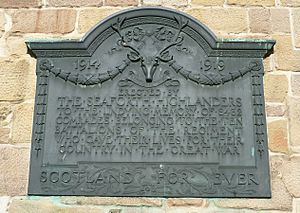
Battle honours are special awards given to military units. They recognize bravery and success in battles or campaigns. The Seaforth Highlanders, along with its older regiments (the 72nd and 78th Highlanders), earned many of these. The ones shown on their regimental flags, called Colours, are listed in bold.
- 72nd Highlanders fought in places like Carnatic, Hindoostan, Mysore, and Sevastopol. They also served in Afghanistan.
- 78th Highlanders earned honours for battles like Assaye, Maida, and Java. They also fought in Persia and at Lucknow.
- Seaforth Highlanders (1881–1902) were recognized for Tel-El-Kebir, Chitral, and Khartoum. They also fought in the South Africa 1899-1902.
- The Great War (World War I) brought many honours. These included Marne 1914 '18, Ypres 1915 '17 '18, Somme 1916 '18, Arras 1917 '18, and Cambrai 1917 '18. They also fought in Palestine and Mesopotamia.
- The Second World War (World War II) added more honours. These included St. Valery-en-Caux, Caen, Rhineland, and El Alamein. They also fought in Sicily, Italy, Madagascar, and Burma.
Victoria Cross Heroes
The Victoria Cross (VC) is the highest award for bravery in the British military. Several brave soldiers from the Seaforth Highlanders received this medal.
78th Highlanders
- Andrew Bogle, 1857, Indian Mutiny
- Joseph Crowe, 1857, Indian Mutiny
- Herbert Macpherson, 1857, Indian Mutiny
- Joseph Jee, 1857, Indian Mutiny
- Valentine McMaster, 1857, Indian Mutiny
- Stewart McPherson, 1857, Indian Mutiny
- Henry Ward, 1857, Indian Mutiny
- James Hollowell, 1857, Indian Mutiny
72nd Duke of Albany's Own Highlanders
- Aylmer Cameron, 1858, Indian Mutiny
- George Sellar, 1879, Afghanistan
Seaforth Highlanders
- John MacKenzie, 1900, Ashanti
- Sidney Ware, 1st Battalion, 1916, First World War
- Walter Ritchie, 2nd Battalion, 1916, First World War
- Thomas Steele, 1st Battalion, 1917, First World War
- Donald MacKintosh, 2nd Battalion, 1917, First World War
- Alexander Edwards, 6th Battalion, 1917, First World War
- Robert McBeath, 5th Battalion, 1917, First World War
- John Meikle, MM.4th Battalion, 1918, First World War


